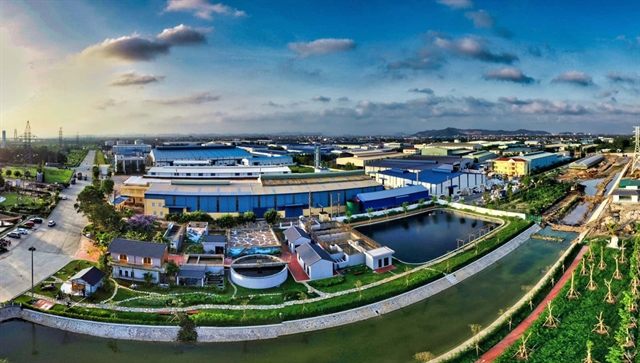 Economy
Economy

 |
| The Nam Cầu Kiền Industrial Park in Hải Phòng City. The conversion to the eco-industrial park model has brought economic, social, and environmental benefits. — Photo vngreen.vn |
HÀ NỘI — The development of eco-industrial parks is not an easy task when there are many obstacles in terms of mechanism, determination and participation of enterprises, experts have said.
An eco-industrial park is a community of businesses that produce and provide goods and services, while also developing and protecting the environment at the same time.
The stricter standards needed for an eco-industrial park require enterprises to invest a large amount of money to meet regulations and comply with a raft of laws to protect the environment and rights of workers while ensuring basic services.
In addition to clean production methods and efficient use of resources, a minimum of 25 per cent of the land needs to be allocated to green buildings. Eco-industrial parks must have a mechanism to monitor and manage effectively inputs and outputs and emissions.
Great benefits
Trương An Dương, general manager of North Industrial & Residential of Frasers Property Vietnam, said eco-industrial parks can bring great benefits, though investing in these parks will incur many costs.
He said the industrial real estate development in the world will require more stringent requirements, related to green certificates in the future.
Investment costs for eco-industrial parks are higher, so impacting selling and rental prices. However, green standards will also bring the park developers a competitive advantage in the market, because foreign investors, especially investors from the US and Japan, are very interested in green development, he told baodautu.vn.
In addition to increasing the firms' competitiveness, the development of eco-industrial parks also brings them many economic and environmental benefits.
Nhã Vinh Julien Nguyễn, country head of WHA Vietnam – an investor of WHA IZ 1 Industrial Park in central Nghệ An Province, also told the online newspaper that developing eco-industrial parks is a good direction as secondary investors, manufacturers and consumers are demanding more sustainable supply chains.
Meanwhile, Giang Ngọc Phương, deputy general director of Hiệp Phước Industrial Park JSC, said the conversion from traditional industrial parks into ecological industrial parks has reduced the use of energy and clean water and environmental emissions, which has helped businesses slash production costs.
According to the Ministry of Planning and Investment (MPI) and the United Nations Industrial Development Organisation (UNIDO), the conversion of existing industrial parks into eco-industrial parks contributed to savings of nearly VNĐ70 billion (US$2.8 million) annually in Việt Nam during 2020-24.
A total of 603 projects have been implemented in industrial parks across the country to convert existing facilities to be greener and more resource-efficient during the period, which has helped reduce CO2 emissions by 8,910 tonnes per year.
Lê Thanh Quân, head of the ministry's economic zone management department, said: "Initial conversion to the eco-industrial zone model has brought economic, social and environmental benefits while mobilising large resources from the private sector for green industrial solutions, ensuring energy security, sustainable development, and climate change adaptation."
By 2030, 40-50 per cent of localities will have plans to convert existing industrial parks to eco-industrial parks and up to 10 per cent of localities have orientations to build new eco-industrial parks to attract investment, according to a summary report on the development of industrial parks and economic zones over the past three decades released by the MPI, which has been approved by the Government.
Problems in development
Despite these, there are many difficulties in the development of eco-industrial parks, experts have said.
To be recognised as an ecological industrial park, businesses operating in this park need to participate in cleaner production activities, effectively use resources and cooperate in industrial symbiosis – a requirement for ecological industrial parks. But this process is not easy, they said.
According to Phương, one of the main difficulties is encouraging businesses in the industrial park to participate in the model, because most of them have almost no experience and do not understand this transformation model.
Meanwhile, there is still no specific incentive mechanism, especially in corporate income tax and tax policies, for developing eco-industrial parks, Phương said, adding that overlapping legal documents between ministries and branches in managing the reuse of industrial waste creates headaches for companies.
Nguyễn Thị Kim Liên, a chemical and environmental expert, said there remains a huge potential for industrial symbiosis in Việt Nam's industrial parks. However, legal and policy issues can be major barriers, she said.
Dương from Frasers Property Vietnam suggested the State draw up more incentive policies to encourage green development, compensating costs for developers. — VNS




